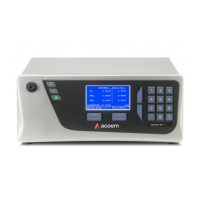Serinus 40 User Manual 2.2
Figure 48 – Return to normal mode notice
8. Reconnect external tubing to the rear of the analyser.
5.7 High Pressure Zero/Span Valve
If the analyser was ordered with this option, the internal pressurised calibration valves will already
be installed within the analyser as either a zero or span calibration source, thus no other internal
connections need to be made.
Note: This is not intended as a source for calibrating the instrument. This should only be used as an
operational check of the instrument’s zero point and single upscale point (recommended as 80%
of full scale).
5.7.1 Single Pressurised Calibration Option
Operation of Single Calibration Option
When using the pressurised calibration option, either a high pressure zero or span bottle should be
connected to the Auxiliary In Port on the back of the analyser.
1. Ensure the gas cylinder is fitted with an appropriate gas regulator with a shut off valve.
2. Connect a line of stainless steel tubing between the gas cylinder and the analyser’s Auxiliary Port
inlet (refer to Figure 49).
Note: This connection may need to be retightened during this operation.
3. Open the cylinder main valve and adjust the regulator to 15 psig or 1 bar.
4. Open the regulator’s shut off valve and test for leakage.
5. Temporarily place a flow meter on the calibration port inlet (used as a span/zero gas vent during
this check).
6. Enter the Calibration Menu (Main Menu → Calibration Menu).
7. Change Set Cal Port to External.
8. Select either Span or Zero under the Cal Mode option depending on which calibration check is
being performed. This will initiate the pressurised calibration.
9. Open the shut off valve on the cylinder, and adjust the regulator pressure until the flow on the
vent line (Calibration Port) is between 0.5 and 1 lpm.
Note: Do not exceed a pressure of 2 bar, this can damage the analyser and cause gas leakage.

